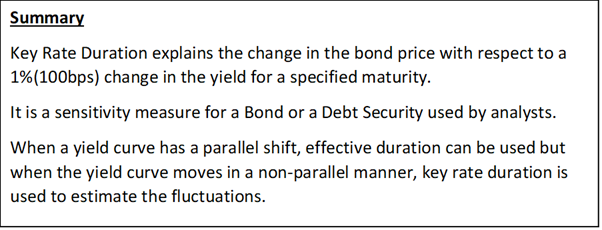What do you mean by Key Rate Duration?
Key rate duration estimates how the worth of a debt security or an obligation instrument portfolio, primarily bonds, changes at a particular development point along with the sum of the yield curve. When keeping other developments consistent, the key rate duration is utilized to quantify the affectability in an obligation security's cost to a 1% change in yield for a particular result.

Copyright © 2021 Kalkine Media
Understanding Key Rate Duration
Key rate duration is a significant idea in assessing the regular changes in value for security or arrangement of securities. It does so when the yield curve shifts in a way that isn't equal, which happens frequently.
Another significant security metric is effective duration, a vital span measure that additionally figures anticipated changes in cost for a security or arrangement of securities given a 1% change in yield. Yet, it is just substantial for equal changes in the yield curve. This is the reason the key rate duration is an essential measurement.
Key rate duration and effective duration are connected. There are 11 developments along the Treasury spot rate curve, and a key rate curve might be determined for each. The amount of all the 11 key rate durations and the portfolio's yield bend equivalent to the successful span of the portfolio.
The key rate duration is viewed as a better measurement than effective duration. It is on the grounds that the effective duration metric is simply material to resemble shifts in the interest rates and the yield bend, which means when financing costs for all the other security developments at the same time increment or decline by a similar sum.
In actuality, this situation is very rare and does not occur quite often. Financing cost increments or diminishes for transient securities don't usually resemble rate increments or decreases for the long haul or medium-term securities. Loan costs for various securities developments may be moving in inverse ways, with, for instance, long haul interest rates expanding while the financing cost on short term bonds is declining. The key rate duration addresses an improvement over the successful length measure since it demonstrates anticipated changes in value/esteem when shifts in the yield bend are not equal across all developments.
In the event that a financial backer knows how the individual in question expects interest charges to move over a given time period, they would then be able to utilise the key rate duration metric to sort out which security developments are probably going to offer the most beneficial speculation returns. In this way, the measurement can be utilised to analyse different planned fixed-pay speculations.
Another situation where computing key rate duration might be valuable is the point at which a financial backer holds callable security. They might need to gauge the adjustment of the bond they have, given different premise point changes. Doing so can help them estimate the probability of their bond being called for early reclamation by the guarantor.
It very well may be hard to decipher an individual key rate duration since it is far-fetched that a solitary point on the depository yield curve will have an upwards or downwards shift at an unattended issue while all others stay consistent. Nevertheless, it helps see key rate spans across the bend and taking a gander at the overall upsides of key rate terms between two protections.
On the Treasury spot bend, there are 11 developments. Along these lines, key rate duration can be determined for every development. The amount of all key rate spans on the yield curve will be equivalent to the effective term. To appraise a portfolio's adjustment of significant worth in case of a non-equal yield bend, an investigator should play out a weighted normal computation using the key rate duration to the portfolio's loads at various developments (i.e., the percent contributed at long term, long term, long term, and long-term securities).
For instance, expect security X has a one-year key rate duration of 0.5 and a five-year key rate term of 0.9. On the other hand, security Y has a key rate duration of 1.2, and 0.3 for these development focuses. Thus, it very well may be said that security X is half just about as delicate as security Y on the transient finish of the curve. In contrast, security Y is about one-third sensitive to interest rate changes.
Frequently Asked Questions
What are the differences between Key Rate Duration and Effective Duration?
Key rate duration is not equivalent to effective duration. Effective duration is a measurement of a security's affectability to an equal change in interest rates, implying that it expects that financing costs change by a similar degree for, say, one-year bonds, five-year bonds, 10-year bonds, and 30-year bonds. That is not regularly the situation in reality, which is why the key rate duration is valuable -- it estimates a security's value affectability to shifts at key focuses along the yield curve.
Key rate duration is beneficial for protections with implanted alternatives, for example, call choices or prepayment choices. The key rate duration is viewed as a better measurement of effective duration. It is on the grounds that the powerful span metric is simply material to resemble shifts in loan fees and the yield bend – when financing costs for all the other security developments at the same time increment or decline by a similar sum.
Financing cost increments or diminishes for transient securities don't typically resemble rate increments or decreases for the long haul or medium-term securities. Loan costs for various securities developments may even be moving in inverse ways, with, for instance, long haul loan costs expanding while the financing cost on short bonds are declining. The key rate duration addresses an improvement over the successful length measure since it demonstrates anticipated changes in value/esteem when shifts in the yield bend are not equal across all developments.
 Please wait processing your request...
Please wait processing your request...